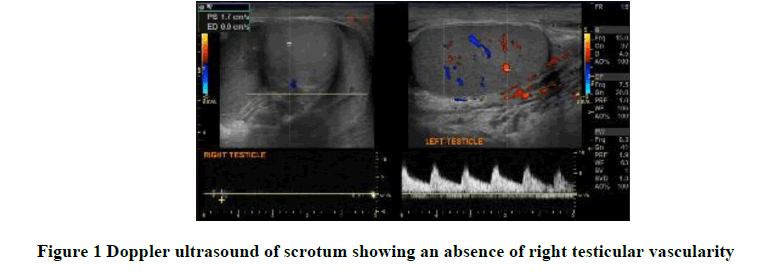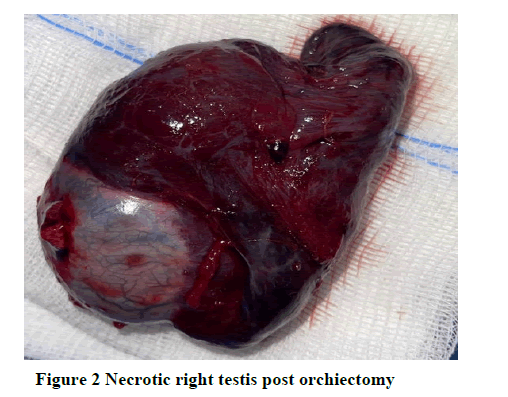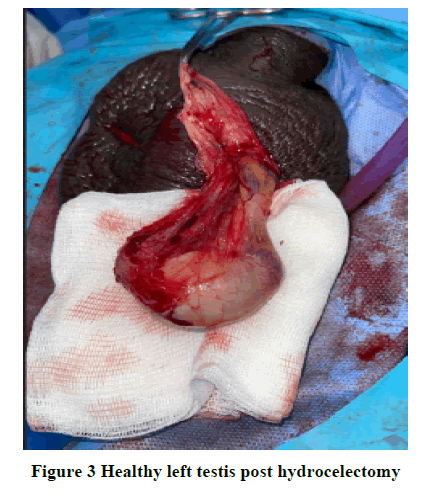Case Report - International Journal of Medical Research & Health Sciences ( 2022) Volume 11, Issue 12
Confirmed Testicular Torsion in A 54 year old : A case report
Abdulkareem Aloqbawi*Abdulkareem Aloqbawi, Department of Urology, King Saud Bin Abdulaziz University, Riyadh, Saudi Arabia, Email: abdullah421@ksau-hs.edu.sa
Received: 23-Jun-2022, Manuscript No. IJMRHS-22-67459; Editor assigned: 27-Jun-2022, Pre QC No. IJMRHS-22-67459(PQ); Reviewed: 11-Jul-2022, QC No. IJMRHS-22-67459; Revised: 22-Aug-2022, Manuscript No. IJMRHS-22-67459(R); Published: 11-Oct-2022
Abstract
Testicular torsion is defined as the wrapping of one testicle or both or the spermatic cord around themselves inside the scrotum, and it is considered a urological emergency due to the increased risk of vascular ischemia of the testis. Young patients who are diagnosed with testicular torsion usually present with acute painful scrotal swelling that suddenly starts, on the other hand, elderly can be presented with only scrotal swelling as our patient presented. In this case report, we describe a rare presentation of a 54‐year‐old gentleman who presented to the Emergency Department (ED) with a history of 5 days of scrotal swelling and was diagnosed to have unilateral testicular torsion.
Keywords
Urological emergency, Acute scrotum, Testicular torsion, Elderly, Geriatric urology
Introduction
Testicular torsion is defined as the wrapping of one testicle or both or the spermatic cord around themselves inside the scrotum, and it is considered a urological emergency due to the increased risk of vascular ischemia of the testis [1]. Of all emergency department visits, about 0.5% of them are related to scrotal issues, one quarter of these cases are diagnosed as testicular torsion [2]. Testicular torsion is considered rare with an incidence of 5.9 per 100,000 males under 18 and 1.3 per 100,000 males older than 18 [3].
Testicular torsion can affect one testis or both of them at the same time. Unilateral testicular torsion mainly affects adolescents and neonates in a bimodal distribution, whereas bilateral torsion mainly affects neonates [4]. Moreover, bilateral torsion is less common than unilateral torsion, causing less than 2% of all reported torsion cases.
In this case report, we describe a rare presentation of a 54‐year‐old gentleman who presented to the Emergency Department (ED) with a history of 5 days of scrotal swelling and was diagnosed to have unilateral testicular torsion.
Case Presentation
A 54 years old male who’s known to have diabetes on metformin, he presented to the emergency department complaining of right sided scrotal swelling which started 5 days before presentation it was associated with scrotal pain 5 days ago then the pain subsided spontaneously without analgesia despite the swelling which was increasing since then. On physical examination, the patient was vitally stable. On inspection of right hemiscrotum was enlarged and swollen with redness no pus discharge or signs of infection, and the left hemiscrotum was unremarkable. On palpitation right testis was not palpable and there was a hard mass like lesion without hotness, crepitation, or fluctuation with negative trans illumination, and the left testis was unremarkable. All labs were within normal range. Doppler ultrasound of the scrotum was obtained which showed an absence of right testicular vascularity suspecting testicular torsion (Figure 1). A parenteral antibiotic was started, and a scrotal exploration was performed. Inspection of the right testis revealed a markedly dusky enlarged, necrotic testis decision of right scrotal orchiectomy was performed (Figure 2) of malignancy. The left testis was also explored hydrocele was inspected, hydrocelectomy plus orchiopexy was performed (Figure 3). The postoperative course was uneventful.
Results and Discussion
Testicular torsion is considered a surgical emergency that needs surgical exploration once it’s confirmed. Frequently presented among children and adulthood age rather than the elderly, yet it should be considered once a patient presented with scrotal pain and swelling.
Young patients who are diagnosed with testicular torsion usually present with acute painful scrotal swelling that suddenly starts, on the other hand, elderly can be presented with only scrotal swelling as our patient presented. Because of its rarity, the majority of elderly who present with painful scrotal swelling, epididymo-orchitis is considered as the main cause, which can explain misdiagnoses of testicular torsion and ultimately ended up with testicular atrophy or orchidectomy [5].
Doppler ultrasound was shown to have 100% sensitivity and 100% negative predictive value for torsion (study), which is becoming an increasingly accepted first-line investigation for any acute scrotal pain, particularly in the elderly male where the diagnosis of epididymo-orchitis [6].
Conclusion
In conclusion, testicular torsion should be considered in all patients who come to the emergency department with scrotal swelling with or without testicular pain in all patient age groups to avoid unnecessary tissue loss. Bedside Doppler ultrasound is an easy, cheap, fast and accurate investigation to rule out torsion. Early detection of torsion corresponds to a higher rate of tissue survival.
Author Contribution
AJA and AAR conceived and designed the study, provided research materials, and collected and organized data. AMA and AA analyzed and interpreted data. OA and IA and wrote initial and final draft of article, and provided logistic support. All authors have critically reviewed and approved the final draft and are responsible for the content and similarity index of the manuscript.
Conflict of Interest
The authors of this manuscript certify that they have NO affiliations with or involvement in any organization or entity with any financial interest (such as honoraria; educational grants; participation in speakers' bureaus: membership, employment, consultancies, stock ownership or other equity interest; and expert testimony or patent licensing arrangements) or non-financial interest (such as personal or professional relationships, affiliations, knowledge or beliefs) in the subject matter or materials discussed in this manuscript.
References
- Smith T, et al. A rare case of bilateral testicular torsion in a 57-year-old man. Journal of the American College of Emergency Physicians Open, Vol. 2, No. 5, 2021, pp. e12545.
- Thomas SZ, Diaz VI and Rosario J. Emergency Department Approach to Testicular Torsion: Two Illustrative Cases. Cureus, Vol. 11, No. 10, 2019, pp. e5967.
- Blaivas M and Brannam L. Testicular ultrasound. Emergency Medicine Clinics of North America, Vol. 22, No. 3, 2004, pp. 723-748.
- Davol P and Simmons J. Testicular torsion in a 68-year-old man. Urology, Vol. 66, No. 1, 2005, pp. 195.
- Potent K and Thyer I. Testicular torsion in a 65‐year‐old male identified using Doppler ultrasound. ANZ Journal of Surgery, Vol. 84, No. 5, 2014, pp. 395.
- Altinkilic B, Pilatz A and Weidner W. Detection of normal intratesticular perfusion using color coded duplex sonography obviates need for scrotal exploration in patients with suspected testicular torsion. Journal of Urology, Vol. 189, No. 5, 2013, pp. 1853-1858.



